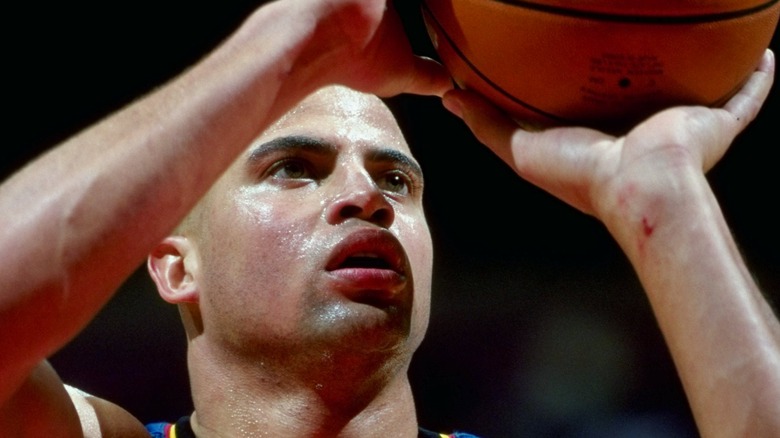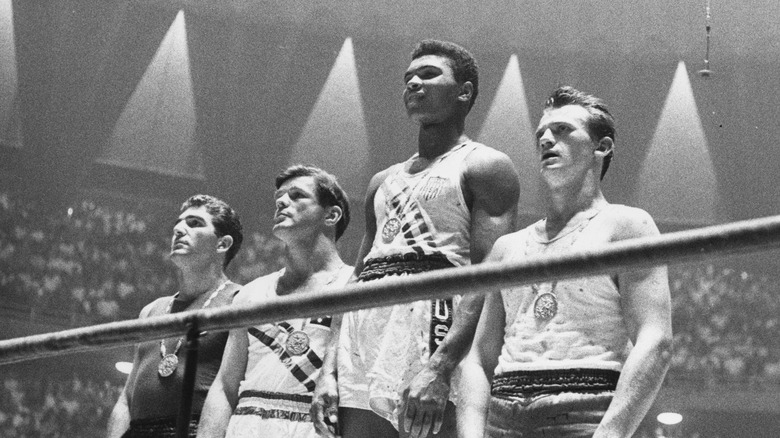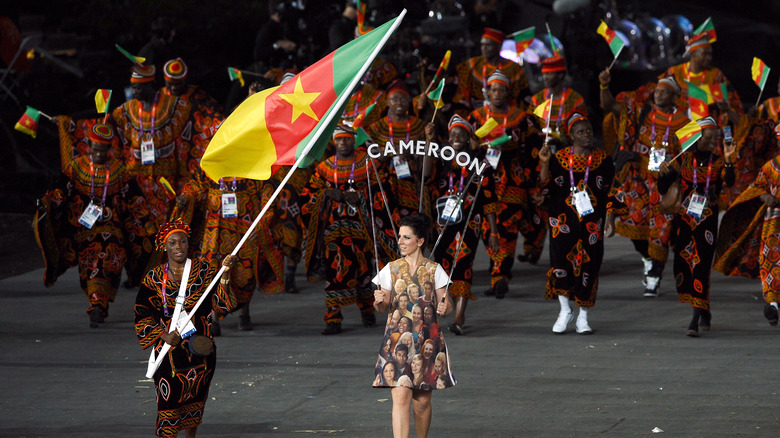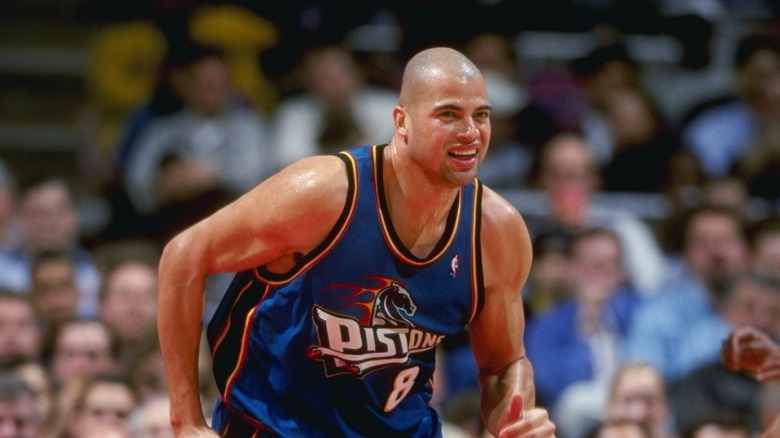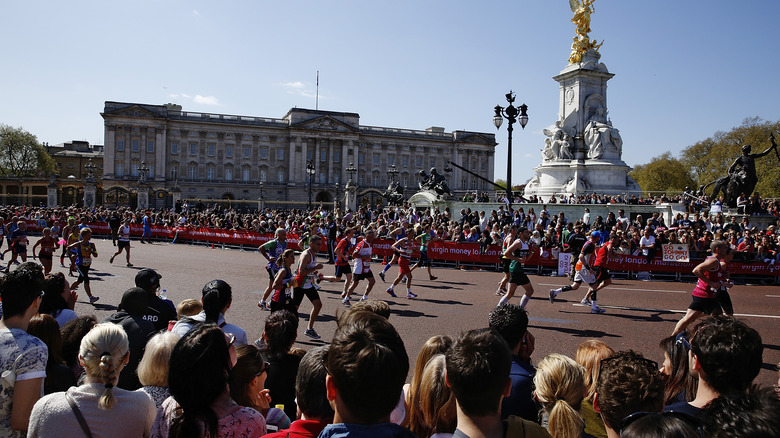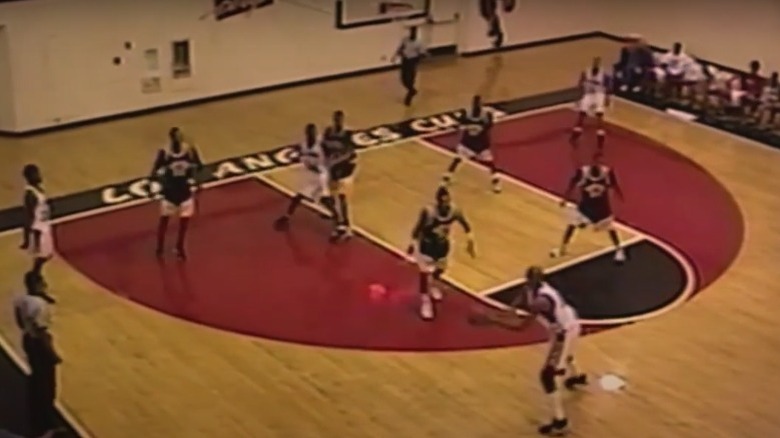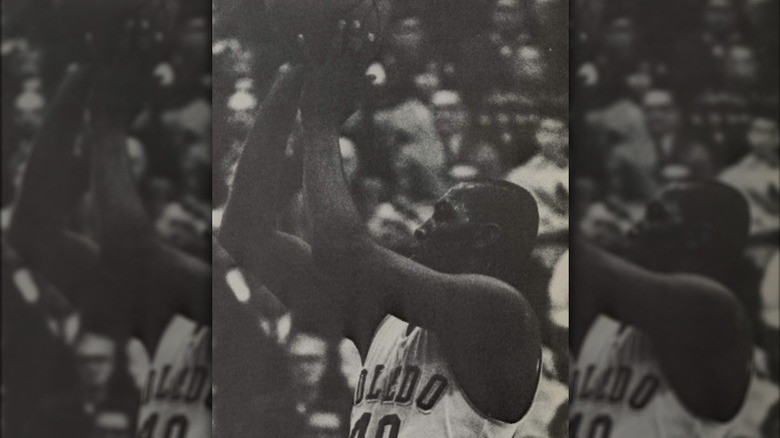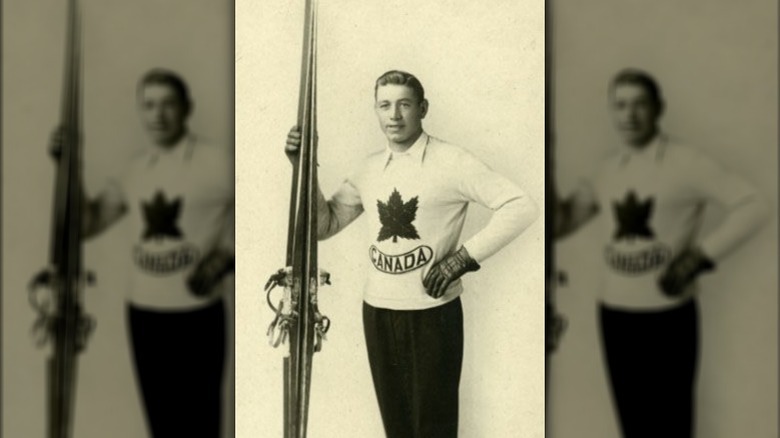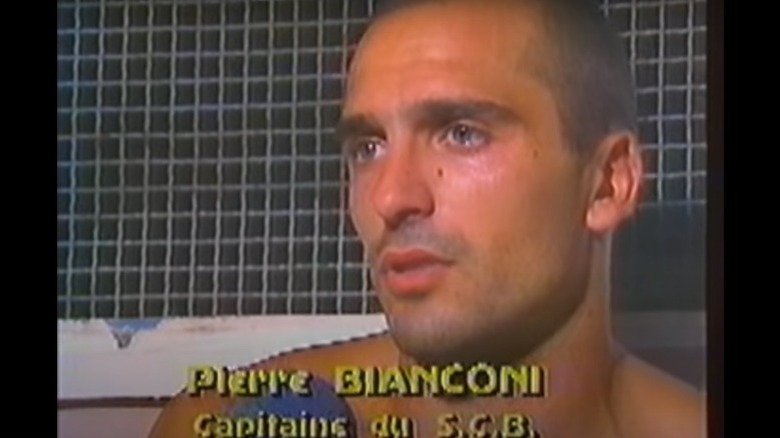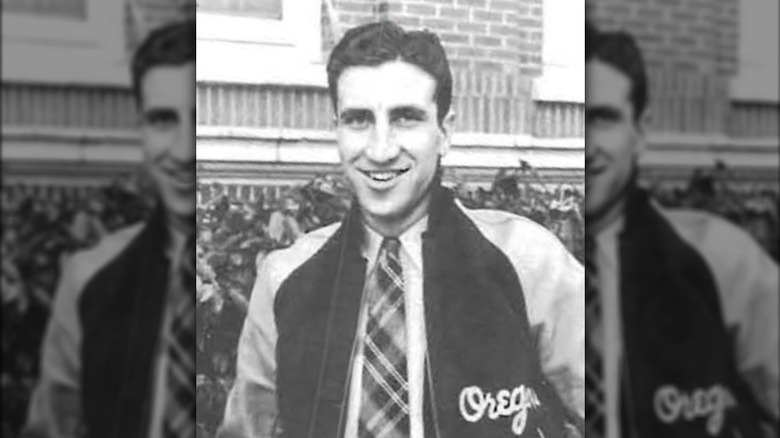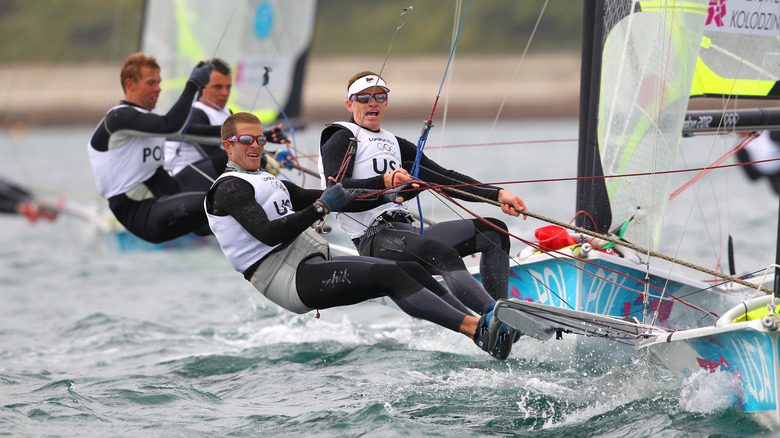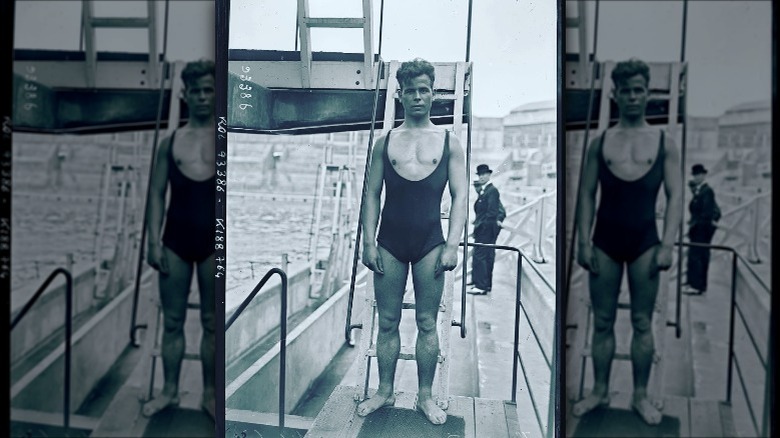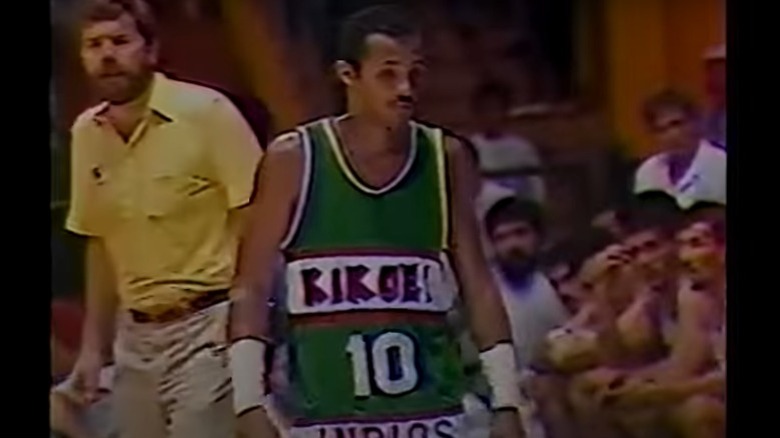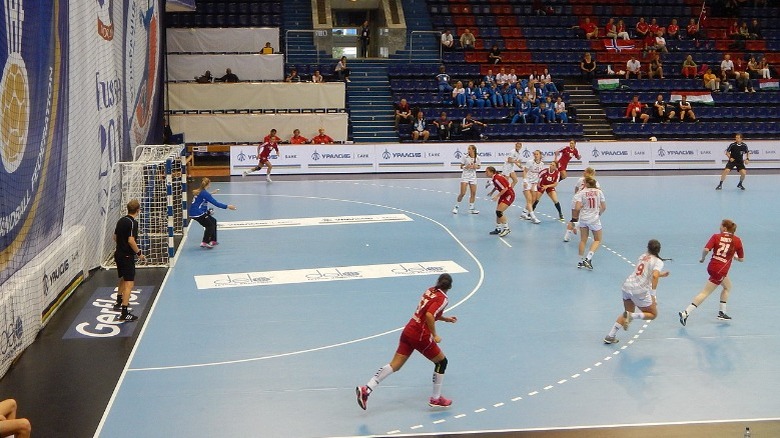Athletes Who Went Missing And Were Never Found
While some sports stars are world-famous, their faces plastered on billboards and cereal boxes in dozens of countries, most of those who choose sports as a career path remain mostly anonymous. That means that if they were to suddenly disappear, it's unlikely they would be recognized by the average person.
Athletes have disappeared seemingly into thin air for a variety of reasons, and some of them were bigger stars than you might expect. In some cases, it's pretty likely they came to harm, in others they clearly chose to leave their lives behind, and then there are the disappearances that seem to defy explanation.
Regardless of what happened to these athletes, or if it would even be possible for some of them to still be alive, figuring out what happened to them would bring closure to a lot of people. Hopefully, someone out there has answers. Here are athletes who disappeared and are still missing today.
Jim Robinson
Over the course of his professional career, boxing great Muhammad Ali (pictured winning gold at the 1960 Olympics) fought 50 different men in 61 fights. Some of those opponents are equally iconic, and their bouts have gone down in history. In 1999, Stephen Singer, who already had an extensive collection of Ali memorabilia, according to The Boston Globe, decided to add a collection-within-a-collection that no one else had: he planned to get the signatures of each of those 50 opponents. Amazingly, it only took him four years and about $35,000 in early-2000s money ... to get 49 of them. The 50th signature, of Ali's early opponent Jim Robinson? Seemingly impossible to find. As was Robinson himself.
A last-minute replacement to fight Ali (then Cassius Clay) in his fourth professional match, Robinson didn't stand a chance, per ESPN. But that fight meant his name was recorded in boxing history. Over his 7-year career, he only won five of his 28 bouts. And then...? "I guess he was a man of limited skills and education, and that when his boxing career was over he just kind of disappeared into the sunset," Singer explained. "He was like hundreds of fighters who look to boxing for the American dream, and when they fall there's no net to catch them. There are lots of Jimmy Robinsons."
When Singer contacted ESPN writer Wright Thompson for assistance finding the boxer, the reporter spent six years trying to find out what happened to Robinson and came up empty. It seems not even his old friends knew what happened to him.
Two Cameroonian London 2012 Olympians
For athletes that come from countries with high levels of poverty or physical danger, international sporting events can offer something even more important than the chance to show off their athletic abilities: it can be a chance to claim asylum. This happens relatively often, with British tabloid The Mirror compiling examples from Olympic Games from 1948 to the delayed 2020 Olympics in Japan. In many cases, these athletes only disappear temporarily, and then turn up again once they officially apply for asylum. But this doesn't always happen.
At the 2012 Summer Games in London, seven athletes from Cameroon absconded over the course of the event, per The Guardian. "The conditions in Cameroon are very difficult – there are no opportunities here and if you have the chance to go the U.K., it's understandable that you would want to stay there," Henri Tchounga, a tour guide in the African country told the paper.
Five of those who disappeared were boxers, and they all resurfaced a week later at a gym in the British capital, and were later granted asylum. But the remaining two athletes – women's soccer team reserve goalie Drusille Ngako and swimmer Paul Edingue, according to the BBC – never turned up again. While they had valid visas to be in the country until November 2012, after that they would have needed to apply for asylum, and it appears they never did.
Bison Dele
Born Brian Williams before asking people to call him Bison Dele (although he never legally changed his name, according to The Edwardsville Intelligencer), the NBA player spent the 1990s hopping between teams, winning a championship with the Chicago Bulls in 1997. But in 1999, still only 30 years old, he turned down a new $35 million contract from the Detroit Pistons and gave up the game entirely to travel and enjoy life. Three years later, he disappeared.
Dele was on a sailing trip in the South Pacific on his boat Hakuna Matata with his girlfriend Serena Karlan and his older brother Miles Dabord, as well as the captain Dele had hired, Bertrand Saldo. Then, Sports Illustrated reports, everyone stopped hearing from them. Eventually, Dabord and the boat turned up, but the other three were never seen again.
The seemingly obvious answer is that Dabord killed the three other people on the boat, but despite an FBI investigation and many investigative reporters looking into it, this has never been proven, and no hint of the three has ever turned up. The brothers had a complicated relationship, Rocky Mountain News reported, and the trip was supposed to help mend their estrangement. No witnesses reported anything more than brotherly squabbles between the two on the trip, so it's unclear what could have happened to enrage Dabord so much he would kill his 6'11 brother and two innocent bystanders. If Dabord was responsible, he didn't have long to admit to it, since he died of an insulin overdose less than three months after Dele disappeared.
Mami Konneh Lahun
Mamie Konneh Lahun was a long-distance running prodigy. According to The Guardian, the Sierra Leonean runner was quickly becoming one of the best female marathon runners in the world despite never having any formal training. In 2014, at 24-years-old, Lahun came in 20th out of the women competitors in the prestigious London Marathon. Her friends, family, and fellow athletes saw superstar possibilities for her. But when the race was over, Lahun disappeared.
At first, there were conflicting stories about what happened to her. Since she had virtually no money on her, no belongings other than the clothes on her back and her passport, and didn't know anyone in Britain, her manager worried something bad had happened to her. But News.com.au reports it became clear Lahun had intended to disappear, before she suddenly called a friend and said she was coming back to Sierra Leone. Newspapers subsequently reported Lahun had been found "safe and well," per The Independent, only to retract those stories when it turned out no one knew where she was still.
While it is not uncommon for athletes to abscond during international events, Lahun was so talented that some thought it would have been better if she had simply continued her career. Her manager told The Guardian, "It's tragic, because her result was just so good. She doesn't know how good she is." And fellow runner Idrissa Kargbo explained, "If she comes [home], it's good for her career. If she doesn't, her career is over. She will have to forget about running."
Rico Harris
Rico Harris might have been a far bigger name in basketball if things had gone differently. According to Fox Sports, his mother always said he "was born to play basketball" while a former college teammate said, "He could do it all. He was Lamar Odom before Lamar Odom." But Harris seemed to have a talent at self-sabotage as well, failing out of various colleges or losing scholarships after an illustrious high school career, which saw his name routinely included on lists of the best young players on the West Coast.
Harris would not make it to the NBA as it once seemed he would. After playing with the short-lived International Basketball League, he joined the Harlem Globetrotters in 2000 for what a team spokesman would later call "a brief stint," per the New York Daily News. An argument on the streets of LA ended Harris' career at just 24-years-old when he was smashed over the head with a baseball bat, resulting in persistent headaches and issues with balance.
Fast forward to 2014, and things were looking up, as Harris had a job interview and a girlfriend in Washington. While driving from LA to Seattle, he was in contact with both his girlfriend and his mother. He told the former he was going to rest for a bit, pulled over in the wilderness, and disappeared. His car was found with battery and gas remaining, and no signs of foul play. Harris had no known physical or mental health issues, and an air and ground search turned up nothing. He was just gone.
John Brisker
The Seattle Times calls John Brisker a "talented but volatile forward" for the city's NBA team in the 1970s. After years of fighting with players, Brisker eventually left pro-basketball in 1975. Three years later, he had become a father and decided to start a new business: an import-export venture that required travel to Africa, specifically Uganda.
About a month after Brisker arrived on the continent, his girlfriend got a final phone call from him. He was in Uganda's capital, Kampala. That was the last time anyone ever heard from John Brisker.
In the late 1970s, Uganda was in the grips of the psychopathic dictator Idi Amin. This, combined with the mysterious disappearance, has led to many conspiracy theories about what happened to Brisker. One former teammate heard he was killed "and Idi Amin had him prepared and they served him ... banquet style." Another heard that during a dinner Brisker dishonored a king, who pulled a gun out from under a turkey and shot the former player. Even the Associated Press jumped to conclusions, reporting in 1980 that Brisker had been shot, even though there was no evidence for this. And even Brisker's family didn't seem to know exactly where he was, with one brother thinking he'd gone to Nigeria, not Uganda. One of the craziest theories is he died at Jonestown, despite the cult being located in South America, not Africa, per Seattle Pi. With no evidence for any of these theories, Brisker was finally declared legally dead in 1985.
Bob Lymburne
Canadian Bob Lymburne was born in 1909 and despite living in a very cold and snowy country, "Powder Pioneers: Ski Stories from the Canadian Rockies and Columbia Mountains" says that he isn't believed to have ever put on skis until he was already a teenager. Once he did, though, Lymburne fell in love with it, even building his own ski jump in rural Western Canada. Within just a few years he was competing, and after a bit of a rocky (pun intended) start, he began breaking records, in a career that "Powder Pioneers" called "outstanding and meteoric." Lymburne made it to the 1932 Winter Olympics in Lake Placid, although he only placed 18th. This showing seemed to spur him on even more, and he dedicated himself to training for 1936.
There would be no second Olympics for Lymburne, though. In 1935, while practicing, he fell and hit his head. Olympedia says the resulting concussion was so bad it ended his athletic career. Lymburne continued the day job he'd held before as a firefighter, but the loss of his passion obviously affected him deeply.
Even though he could not enjoy the great outdoors competitively anymore, Lymburne still liked to go for walks through the woods. However, over 20 years after his accident, sometime around 1957, Lymburne went for a walk and never came back. Questions about his mental state at the time make it unclear if this was deliberate. While it is likely he died in the Canadian wilderness, there is no proof of what happened to him after he disappeared.
Pierre Bianconi
Soccer in the 1980s and '90s was arguably rougher on and off the field than it is today. Pierre "Pierrot" Bianconi, a defender for various European teams who was originally from Corsica, often went a bit too far, according to the French-language site SoFoot.com. Bianconi was famous for his vicious tackles, and once, when given a red card for slapping a player, he ripped the card up in the referee's face before headbutting him.
But he was also remembered as extremely caring. When fans invaded the pitch after a match, one was beaten by a security guard, so Bianconi ran over and fought off the guard. When a stand collapsed during another match, Bianconi ran straight into the rubble to rescue spectators. And he was devoted to his family, allegedly even planning to get sent off during matches occasionally so he would have a few days to return to Corsica to see them.
Bianconi was devoted to his island home, a part of France (and where Napoleon Bonaparte was originally from). There were strong rumors Bianconi was part of the nationalist movement there, which wanted Corsica to secede from France and become its own country. So when Bianconi disappeared on December 29, 1993, rumors swirled this affiliation had something to do with it. Just what it could have been is unclear, however. According to the French-language site Corse Matin, Bianconi's sister remembers him being a bit more withdrawn than normal that holiday, but simply said he'd see her later before disappearing forever.
Urgel 'Slim' Wintermute
As a member of The University of Oregon basketball team, Urgel "Slim" Wintermute was exceptional, leading the school to victory in the first-ever NCAA Basketball Tournament in 1939. His coach, Howard Hobson, later said (via The Eugene Register-Guard), "He was in his day the best center in the country. I've always said that he was the best defensive center I've ever coached. In fact, he's the best collegiate defensive center I've ever seen."
The Oregon Sports Hall of Fame says that after the two-time All-American graduated, Wintermute played professionally for Detroit in the National Basketball League (the NBA would not exist for several more years). He later played for and coached the Portland Indians of the Pacific Coast Basketball League. After his sports career ended, Wintermute went to work for Boeing.
In 1977, The Eugene Register-Guard reported that Slim Wintermute was missing. He'd been out on a 37-foot boat with a friend on Lake Washington when he vanished. The friend said he'd been napping, but that Wintermute had definitely been there when he fell asleep. Wintermute had called his work that morning to say he wasn't coming in, which was the last time anyone on the mainland heard from him. However, the police and Wintermute's family didn't think the friend had harmed him or anything like that. The former player had already had one heart attack in 1970, so it was theorized he might have had another one and fallen overboard. However, his body was never found and it's not clear what really happened.
Trevor Moore
A few of the athletes on this list disappeared while on the water, and while they are officially classified as missing since there is no sign of what happened to them, you'd assume in most cases it involved their bodies ending up in the water, which is why they were never found. But when one of those athletes is an Olympic-level sailor? Then it makes a lot less sense why the water would be a possible danger for him.
Trevor Moore knew what he was doing on a boat, and was on the 2012 U.S. Olympic sailing team, where he placed 15th in the skiff event, per NBC News. He expected to return to the Olympics again, and spent his free time teaching others to sail. His father told The Washington Post that Moore had always had a natural talent for sailing and had been sailing in Biscayne Bay since he was just 7 years old.
So it was unthinkable that something could have happened to Moore on a calm day on that same bay in 2015. But after going out for a quick sail, Moore never returned. His boat did, however, which is when his disappearance was discovered. Only 30 years old at the time, it's unlikely Moore suffered a heart attack or stroke. His college sailing coach said that sometimes things just happen out there: "The more time you spend around the water, you learn to love and respect the powers of the ocean. I think for all of us, something happened, and we'll never know what."
Hannes Kärkkäinen
The 21-year-old Hannes Kärkkäinen represented Finland in men's platform diving at the 1924 Summer Olympics in Paris, per Sports Reference. While he beat out 11 divers and made the final, he then placed last of the remaining nine competitors.
Just two years after his Olympics showing, Kärkkäinen left Finland. And then – no one knows. At the time it was not that unusual to lose track of people from that country who immigrated somewhere else, often the United States, according to OlympStats. At least three other Finish Olympians from the early years of the Games also fell off the map eventually, although in their cases there is at least some evidence of where they went and what they did, at least for a period of time.
Hannes Kärkkäinen, on the other hand, is a complete enigma, with OlympStats calling his disappearance "the most mysterious of all." The two most common theories about what happened to him could not be more different. The first is that he headed for the U.S., eventually settling in Connecticut. The second theory is that in 1938, Kärkkäinen became a victim of the Soviet Union's Great Purge. Either way, he is certainly not alive now, and officially he died on January 1, 1993, the date given by the Finnish courts when declaring him dead in absentia.
Angelo Cruz
Angelo Cruz grew up playing basketball on the street courts of New York City, per The New York Daily News. Despite being extremely short for a basketball player at just 5'7", he made up for it with his abilities, which included incorporating acrobatics into his game. After playing for high school and college teams for a short time, Cruz moved to Puerto Rico where he joined the island's professional league and won two championships with his team. He also played for Puerto Rico at the 1988 Olympics (Puerto Rico competes separately from the United States at the Games).
While his celebrity was relatively localized, he was a huge star in Puerto Rico. After Cruz's playing career ended in 1994, he moved back to New York City but had a hard time adjusting to life out of the spotlight. He started using drugs and would disappear for periods of time. His son said Cruz would always turn up eventually "and act like nothing was wrong."
But then one time he didn't turn up. After 1998, none of his family or friends saw Cruz again. They have no idea what happened to him. While it's possible he overdosed and was an unidentified body somewhere, or came to harm in some other way, it's also just as likely he is still alive. That's what his family hopes, and as of 2011, they were holding charity basketball games in his honor and to raise awareness of his disappearance.
Three Congolese handball players
The disappearance of three young athletes from the World Junior Handball Championship in 2014 (pictured: A match from the 2016 championship tournament between Hungary and Norway) didn't make a lot of sense. According to the Croatian language outlet Slobodna Dalmacija, 19-year-old Julie Betu Mvita, 20-year-old Mirnelle Kele Mazenga, and 18-year-old Laetitia Mumbala Mayunga were in Croatia for the finals as members of the Democratic Republic of the Congo's national team.
While the three disappeared from the hotel together and it was believed they had arranged for someone to pick them up in a car, they left all their belongings in the hotel, including their passports. Identification would have been important if they were planning on applying for asylum, which Slobodna Dalmacija notes they probably would have easily qualified for based on the danger present in returning to the DRC.
It appears they did not apply for asylum, or indeed resurface at all. Six weeks after their disappearance, the Croatian language website Jutarnji reported that despite the police conducting an extensive search, the three young women had vanished.
